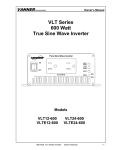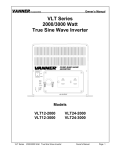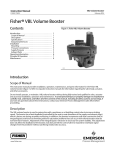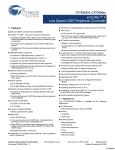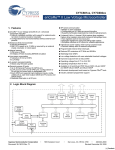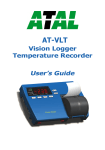Download Vanner VLT24-1500 Owner`s manual
Transcript
Owner’s Manual VLT SERIES True Sine Wave AC Power Inverter 60Hz Models VLT12-600 VLT24-600 VLT12-1000 VLT24-1000 VLT48-1000 50Hz Models VLT12-1500 VLT24-1500 VLT48-1500 VLTE12-600 VLTE24-600 VLTE12-1000 VLTE12-1500 VLTE24-1000 VLTE24-1500 VLTE48-1000 VLTE48-1500 Owner’s Manual D910106 Rev. B Rev. May 24, 2007 VANNER Incorporated Vanner Incorporated 4282 Reynolds Drive Hilliard, OH 43026 800-AC POWER (800-227-6937) Tel: 614-771-2718 Fax: 614-771-4904 www.vanner.com e-mail: [email protected] © Copyright 2007, Vanner Inc. 2 VLT Series True Sine Wave Inverter - Owner’s Manual VANNER Incorporated TABLE OF CONTENTS Section 1: Section 2: Section 3: Section 4: Section 5: Section 6: Section 7: Introduction ................................................................................................................................. 4 Model Listing ............................................................................................................................... 4 Specifications and Features ........................................................................................................ 5 Standard Features ...................................................................................................................... 6 Definitions ................................................................................................................................... 6 Safety Instructions ...................................................................................................................... 7 Readme ...................................................................................................................................... 7 General Precautions ................................................................................................................... 7 Explosive Gas Precautions ......................................................................................................... 8 Battery Precautions ..................................................................................................................... 8 Component Identification and Description of Operation .............................................................. 9 Cooling Fans ............................................................................................................................... 9 Battery Voltage Indicator ........................................................................................................... 10 Load Watt Indicator ................................................................................................................... 10 Over Voltage Indicator .............................................................................................................. 10 Under Voltage Indicator ............................................................................................................ 11 Over Temperature Indicator ...................................................................................................... 11 Overload Indicator ..................................................................................................................... 11 ON/OFF Switch ......................................................................................................................... 11 Inverter Indicator Light .............................................................................................................. 11 GFCI Duplex Receptacle .......................................................................................................... 11 Installation and Setup ................................................................................................................ 12 Unpacking the Inverter .............................................................................................................. 12 Inverter Installation Considerations ........................................................................................... 12 DC Wiring Considerations ......................................................................................................... 12 DC Wiring Installation Procedure .............................................................................................. 13 AC Output Wiring Installation Procedure ................................................................................... 14 Start-up and Test Procedure ..................................................................................................... 14 Inverter Start-up and Testing ..................................................................................................... 14 Preventative Maintenance and Troubleshooting Procedures .................................................... 15 Preliminary Checks ................................................................................................................... 15 Problem Symptoms and Troubleshooting Checks ..................................................................... 16 Appendix ................................................................................................................................... 17 GFCI Test Record ...................................................................................................................... 19 LIST OF FIGURES Figure 1 Figure 2 Figure 3 Figure 4 Inverter Specifications ................................................................................................................. 5 Inverter Top, Right Side & Rear View .......................................................................................... 9 Inverter Top, Left Side & Front View ......................................................................................... 10 GFCI Test Record ..................................................................................................................... 19 VLT Series True Sine Wave Inverter - Owner’s Manual 3 VANNER Incorporated 1. INTRODUCTION Thank you for purchasing a Vanner VLT SERIES Inverter. We are confident that you will be satisfied with its performance and its many features. With proper installation and care, you can look forward to years of service from this high performance product. The VLT SERIES is a family of dependable inverters designed to meet common service requirements of the consumer, commercial and industrial markets. All models of the VLT SERIES produce true sine wave AC output power. This document will describe the operation, technical specifications and installation procedures of the various models and accessories offered in this product family. We suggest that you familiarize yourself with the model numbers of the inverter and optional accessories you have purchased before proceeding with this manual. If you require additional information please contact your dealer, or contact us directly at 1-800-227-6937 (800 AC POWER) or www.vanner.com. WARNING: Before you install and use your VLT SERIES Inverter be sure to read and save these safety instructions. Model Listing The VLT SERIES product line is designed to meet the requirements of a variety of applications. NOTICE: Most models of the VLT SERIES use the same front panel and therefore look identical. To identify the model number of your particular unit it is necessary to refer to the Specification Label located on the right side of the unit or to the Identification Label located on the front. Please note your model and serial number here for future reference. Model No.____________________ Serial No.___________________ Date of Installation ______________ 4 VLT Series True Sine Wave Inverter - Owner’s Manual VANNER Incorporated 2. SPECIFICATIONS & FEATURES Specifications Figure 1 Inverter Specifications Surge (3S) A 16 3.33 24 12 24 12 24 VLTE 48-1500 VLTE 24-1500 16.7 8 48 VLTE 12-1500 VLT 48-1500 VLT 24-1500 VLT 12-1500 VLTE 48-1000 VLTE 24-1000 1500W 1000W 6.67 12 VLTE 12-1000 VLT 48-1000 VLT 24-1000 VLT 12-1000 VLTE 24-600 600W Continuous Output Input Voltage VLTE 12-600 VLT 24-600 VLT 12-600 MODEL VANNER VLT & VLTE INVERTER SPECIFICATIONS 12 48 24 12 24 8.3 48 12 24 48 Output Voltage 120V +/- 3% 230V +/- 3% 120V +/- 3% 230V +/- 3% 120V +/- 3% 230V +/- 3% Output Frequency 60Hz +/- .05% 50Hz +/-.05% 60Hz +/-.05% 50Hz +/-.05% 60Hz +/-.05% 50Hz +/-.05% 25 12.5 Peak Current A Efficiency FL - % 5 10 88 No Load Current 90 92 94 83 < 1 amp 87 88 83 87 25 88 12.5 83 87 88 83 87 88 < 1.0W In Power Saving Mode Output Waveform Pure Sine Wave < 3% THD 120V RMS -10% / +4% O/P Regulation Low Battery Volts 10.7 21.5 10.7 21.5 10 20 40 10 20 40 10 20 40 10 20 40 High Battery Volts 15 30 15 30 16 32 64 16 32 64 16 32 64 16 32 64 Standby Recovery 5 Seconds Operating Temp. 32 to 122F (0 to 50C) Storage Temp. Dimensions Weight -22 to 158F (-30 to 70C) 3”H x 7.25”W x 11”D 6.6 lbs. 4.13”H x 10.83”W x 15.35”D 15.1 lbs. 15.4 lbs. LED Status Low Battery Shutdown, Over Temperature Shutdown, Overload, Inverter ON/OFF Indicator Protection Overload, Short Circuit, Reverse Polarity (fuse), Over/Under Input Voltage, Over Temp. Mounting Inverter may be mounted in any orientation VLT Series True Sine Wave Inverter - Owner’s Manual 5 VANNER Incorporated Standard Features 1. 2. 3. 4. 5. 6. 7. True sine wave 120 volt AC output. Resilient electronic protection designed to handle output short circuits and output overloads. Load Demand Feature to conserve DC power under no load conditions. (Not on 600-watt models.) 15 amp GFCI Duplex Receptacle. Automatic shutoff for low or high battery voltage, overload or over temperature with indicator LEDs. Remote control circuit. (Not present on 600-watt models.) Indicator lights for Low Battery Shutoff, Over Temperature Shutoff, Overload and Inverter ON/OFF/Load Demand status. 8. Thermostatically controlled cooling intake fan. Definitions Load Demand Feature and Load Demand Mode: The Load Demand Feature is an energy conserving feature which allows the inverter to enter the ‘Load Demand Mode’ whenever the inverter is ON and the AC load has been less than 10 watts for approximately 10 seconds. While in the ‘Load Demand Mode’ the inverter does not produce 120 volts AC but instead produces pulses of voltage which the inverter uses to look for a load. When a load greater than 10 watts is sensed, the inverter will turn fully ON to produce 120 Volts AC. The ‘Load Demand Mode’ is often also described as ‘stand-by mode’ or ‘sleep mode’. While in the ‘Load Demand Mode’ 12-volt models consume approximately 0.1 amps of DC and 24volt models consume approximately 0.05 amps of DC. Load Demand can be turned off by setting factory setup DIP switch #4 to the up position. 6 VLT Series True Sine Wave Inverter - Owner’s Manual VANNER Incorporated 3. SAFETY INSTRUCTIONS README WARNING: Before you install and use your VLT SERIES AC Power Inverter, be sure to read and save these safety instructions. This manual contains important safety and operating instructions for the Vanner Power Group VLT SERIES Power Inverter as prescribed by Underwriters Laboratories (UL). The VLT SERIES inverters are designed to be compliant with UL 458, Power Converters/Inverters and Power Converter/Inverter Systems. NOTICE: The output waveform of the VLT SERIES inverter is sinusoidal. Total harmonic distortion is less than three percent. CAUTION: Read owners manual BEFORE wiring or powering up. CAUTION: Not intended for DC input directly from a solar array. Batteries must be used. CAUTION: DO NOT cover or obstruct ventilation openings. DO NOT mount in a zero-clearance compartment. Overheating may result. WARNING: Under high ambient temperature / high-power-output conditions some parts of the inverter may become hot enough to cause burns. The unit should be installed so that it is not to be contacted by personnel. WARNING: This equipment employs components that tend to produce arcs and sparks. To prevent fire or explosion, DO NOT install in confined areas or compartments that contain batteries or flammable materials. WARNING: Improper use of this product may result in risk of electrical shock. Both AC and DC voltage sources are terminated inside this equipment. Use only the ground fault circuit interrupter (GFCI) receptacle(s) or circuit breaker(s) specified in the installation and operating instructions. Other types may fail to operate properly when connected to this equipment. DANGER: Battery connections are for disconnect only, NOT for current interruption. General Precautions 1. Do not expose the inverter to direct water spray or snow. 2. To reduce the risk of a fire hazard, do not cover or obstruct the ventilation openings. 3. Do not install the inverter in a zero clearance compartment. This may result in overheating or diminished performance. 4. To avoid the risk of fire, electrical shock, or injury to persons, do not use attachments not recommended or sold by Vanner Inc. 5. Vanner recommends that all AC and DC electrical wiring be performed by a licensed electrician or a qualified technician to ensure compliance with all applicable national and local wiring regulations. 6. To avoid a risk of fire and/or electrical shock, always verify wiring connections are in good electrical condition. All external conductors must use proper wire size to avoid dangerous overheating or diminished performance. VLT Series True Sine Wave Inverter - Owner’s Manual 7 VANNER Incorporated 7. If the inverter has been dropped or damaged in any way, do not operate the inverter until it has been verified to be safe by a qualified technician. 8. To reduce the risk of electrical shock, always disconnect the AC and DC connections to the inverter before attempting any maintenance. Simply turning the inverter off does not prevent electrical shock. 9. The inverter must be properly grounded in accordance with local and national codes and ordinances before operation. For most installations, the negative (ground) conductor should be bonded to the grounding system at one and only one point in the system. 10. For optimum inverter performance, battery temperature should be above 32 degrees Fahrenheit. 11. Do not disassemble the inverter. See the service section of this manual for instructions on obtaining service. Attempting to service the inverter yourself may result in a risk of electrical shock, fire and/or loss of warranty. Explosive Gas Precautions 1. This equipment contains components, which tend to produce arcs or sparks. To prevent fire or explosion, do not install in compartments containing batteries or flammable materials, or in locations that require ignition protected equipment. This includes any space containing gasoline-powered machinery, fuel tanks, or joints, fittings, or other connections between components of the fuel system. 2. To reduce the risk of battery explosion, follow these instructions, the battery manufacturer instructions, and the instructions of the manufacturer of the equipment in which the battery is installed. Working near a lead-acid battery is dangerous. Batteries generate explosive gases during normal battery operation. Battery Precautions 1. Always have someone within range of your voice to come to your aid when you work near a lead-acid battery. 2. Have close access to plenty of fresh water and soap in case battery acid contacts skin, clothing, or eyes. 3. Always wear complete eye protection and clothing protection. Avoid touching eyes while working near batteries. 4. If battery acid contacts skin or clothing, wash immediately with soap and water. If acid enters eye, immediately flood eye with running cold water for at least 20 minutes. Get medical attention immediately. 5. NEVER smoke or allow a spark or flame near a battery. Gases produced by batteries are explosive. 6. Be careful when working with metal tools around batteries. Potentials exist for sparks or short-circuit of the battery or other electrical part which could cause an explosion. 8 VLT Series True Sine Wave Inverter - Owner’s Manual VANNER Incorporated 4. COMPONENT IDENTIFICATION and DESCRIPTION OF OPERATION Figure 2 Inverter Top, Right Side & Rear View (1) Rear entry for negative DC input cable (2) Rear entry for positive DC input cable (3) Rear entry for Remote Control RS 232 Connection (4) Chassis Ground Bonding Lug (5) Cooling Fans Draw air in through intake vents on the top, sides and bottom of inverter and exhaust it out the back for the purpose of cooling the unit. Fans will not continue running when the inverter goes to sleep. VLT Series True Sine Wave Inverter - Owner’s Manual 9 VANNER Incorporated Figure 3 Inverter Top, Left Side & Front View (6) Battery Voltage Indicator The battery voltage bar graph indicates the voltage at the input terminals of the inverter. At low input current, this voltage is very close to the battery voltage. At high input current, this voltage will be lower than the battery voltage because of the voltage drop across the cable and connections. Ideally, the voltage should remain in the green areas of the bar graph. If the voltage indicator light is in the red areas of the graph, the inverter may shut itself OFF. (7) Load Watt Indicator The AC load watt bar graph indicates the power drawn from the inverter. It will indicate wattage by loads. For long term operation, indicated wattage should be in the green and orange area of the graph. Short term operation is possible with wattage in the red area. If total wattage allowed is reached, the entire bar graph will flash as a warning but the load will continue to be supported. If total wattage allowed is exceeded, the inverter will shut itself OFF. (8) Over Voltage Indicator Indicates that the inverter has shut itself OFF due to input voltage over 16.5 volts (33.0 volts for 24 volt models; 15.0 volts and 30.0 volts for 600 watt models). 10 VLT Series True Sine Wave Inverter - Owner’s Manual VANNER (9) Incorporated Under Voltage Indicator Indicates that the inverter has shut itself OFF due to input voltage under 10.0 volts (20.0 volts for 24 volt models). (10) Over Temperature Indicator Indicates that the inverter has shut itself OFF due to overheating. The inverter may overheat if operated at power levels above its rating, or if installed in a location that does not allow for proper ventilation. The inverter will restart automatically after a cooling period. (11) Overload Indicator The inverter has shut OFF because its output has been short circuited or drastically overloaded. Turn the ON/OFF switch to the OFF position, correct the fault condition, and turn the inverter back ON. (12) ON/OFF Switch (and RESET Switch) The ON/OFF Switch is a two-position rocker switch used to turn the inverter ON/OFF and is used as a RESET Switch. When the inverter has automatically shut itself OFF due to a fault, the inverter must be RESET by turning the ON/OFF Switch OFF or by turning a remote switch OFF. (If an automatic shutdown has occurred due to a fault, one of the fault indicator lights will be displayed until the inverter is RESET. (13) Inverter Indicator Light Light Display Description Green Light is OFF Inverter is OFF Solid Green Inverter is ON and is producing AC power Blinking Green Inverter is in Load Demand Mode (14) Factory set-up dip switch (Not present on 600-watt models.) (15) Air Intake Vents (16) Mounting Base Rails ( 2 ) (17) GFCI Duplex Receptacle VLT Series True Sine Wave Inverter - Owner’s Manual 11 VANNER Incorporated 5. INSTALLATION and START UP Unpacking the Inverter 1. Inspect the shipping container and equipment for loose or damaged parts. If any damage is found, immediately notify the freight carrier. Inverter Installation Considerations 1. Mounting: Locate a secure, dry, flat horizontal or vertical surface large enough to mount the inverter. The location should be as close to the battery as possible, usually within six feet, but not in the same compartment and should provide adequate ventilation while the inverter is operating. The location must be clean, dry and free from road spray, dripping water or other moisture contamination. 2. Cooling Fan Clearance: The mounting location must allow unobstructed airflow for cooling. Allow a minimum clearance of 1½ inches (40 mm) on the left, right and back sides of the inverter. The Cooling Fan is a thermostatically controlled intake fan. Air is drawn into the inverter from the front and side vents and exhausted through the fans. Obstruction of the fan intake or the exhaust vents will diminish the inverter output capacity due to overheating. DC Wiring Considerations 12 1. A DC FUSE IS REQUIRED to properly protect the inverter in case the battery cables are connected backward (reverse polarity). 2. The wiring of your inverter installation should conform to the National Electric Code (NEC) and any other state or local codes in effect at the time of installation. These codes have been written for your protection and their requirements should be followed. Article 551 of the NEC requires any DC cable from a battery, which measures longer than 18 inches along its length, be protected by a fuse. 3. BE AWARE, as a large number of capacitors become charged upon completion of the DC circuit, THERE WILL BE A LARGE SPARK when the last battery connection is made. The spark is normal and will occur every time the batteries are connected. It is advisable to make the last DC connection at the input fuse, not at the battery, to reduce the risk of battery explosion. 4. Route the AC output wiring and DC power wiring with as much physical separation as possible from low voltage wiring such as audio and video signal wires. 5. Route the DC positive and negative cables as close together as possible and use cable ties to keep them together. This reduces electromagnetic radiation that could interfere with sensitive electronics. 6. If passing through steel or other ferrous metal walls, the DC input cables need to pass through the same hole to prevent causing a transformer effect. If two holes are required, cut a slot to connect the two holes to prevent heating of the ferrous metal. VLT Series True Sine Wave Inverter - Owner’s Manual VANNER 7. 8. 9. Incorporated Proper DC cable size is critical for the performance and safe operation of the inverter system. The minimum recommended cable size allows a ½ volt maximum voltage drop at maximum inverter capacity and will insure optimum inverter performance. Quick DC cable connectors are available. Do not use the vehicle chassis as the DC negative conductor. The negative cable should be the same size as the DC positive cable and should be connected directly to the battery negative terminal. DC cables should be as short as possible (no longer than 15 feet to prevent performance loss). VLT Series DC Cable and Fuse Sizing Chart VLT12-600 Model # VLT24-600 VLT12-1000 VLT24-1000 VLT12-1500 VLT24-1500 Distance (positive cable length) from battery to Inverter: 20’ maximum length. Chart is based on negative cable being same length as positive cable. The recommended cable size holds voltage drop to 05vdc max at full load. Cable Size 6 ga 10.0 20’ 20’ 20’ NR 12.0 20’ 20’ 20’ 20’ 20’ Fuse Size (Amps) 80 Mega Fuse PN Mega Fuse Holder 4 ga 2 ga 1 ga 1/0 12.0 NR 8.0 NR 16.0 20’ 20’ 20’ 20’ 11.0 14.0 16.0 20’ 20’ 20’ 20’ 18.5 20’ 60 150 80 200 100 013910 013909 010098 013910 013914 013910 011876 011876 011876 011876 011876 011876 20’ DC Wiring Installation Procedure 1. The DC wiring terminals are located on the right rear of the inverter. 2. Select a location for the inverter. An ideal location is close to the battery; protected from weather and moisture; and well ventilated. 3. Select an accessible location for the DC Fuse. The location should be within 18” of the battery and accessible for visual inspection and replacement. If possible locate so the last DC connection can safely be made at the fuse. 4. Prepare DC cable ends. 5. Verify that the battery positive cable is not connected to the battery. Insert DC cables into the DC wiring lugs. Torque DC cable bolts to 50 inch pounds. Re-torque after 30 days. 6. Route the negative DC cable to the battery. Verify cable polarity before proceeding. The fuse will be blown and inverter can be damaged if the DC cables are reversed. Route the positive DC input cable to the fuse and then to the battery. Protect cables with loom and use grommets or other appropriate means where cables may contact hard, sharp edges. If possible, make the last DC connection at the fuse to avoid causing a spark at the battery. 7. Connect Chassis Ground Bonding Lug to the vehicle chassis and/or earth ground using AWG No.8 or larger copper conductor. 8. Verify that the inverter will turn ON but do not leave the inverter connected to the battery at this time (remove the fuse). Final battery connections will be made after all control and AC output installation issues have been inspected. VLT Series True Sine Wave Inverter - Owner’s Manual 13 VANNER Incorporated AC Output Wiring Installation Procedure WARNING: Before proceeding with the AC wiring, verify that the inverter is OFF and that the inverter is NOT connected to the battery. Serious or fatal electrical shock may occur. 1. The wiring of your inverter installation should conform to the National Electric Code (NEC) and any other state or local codes in effect at the time of installation. These codes have been written for your protection and their requirements should be followed 2. Route the AC output wiring, and DC power wiring, with as much physical separation as possible from low voltage wiring such as audio and video signal wires. 3. Verify AC wiring installation. Verify that all connections are tight. Secure all wiring. Start-up and Test Procedure After the inverter has been properly mounted with sufficient ventilation, DC cables have been connected to the inverter (but not yet to the battery), AC wiring has been completed, and all remote connections have been checked; the Start-up and Testing procedure should be performed. WARNING: These procedures are to be performed only by a QUALIFIED INSTALLER. Inverter Start-up and Testing 1. Place the Inverter ON/OFF switch in the OFF position. 2. Place any remote switches in the OFF position. 3. Verify that any external AC output circuit breakers and GFCI receptacles are reset. 4. Connect the battery to the inverter. BE AWARE, as a quantity of capacitors become charged upon completing the DC circuit, THERE WILL BE A LARGE SPARK when the last connection is made. 5. Turn the inverter ON and use a test load (75 watt trouble light) plugged into the 15 amp GFCI receptacle to verify the inverter produces AC power. 6. Refer to the description of operation of the indicator lights, Section 2, items 4 through 10 to follow and verify correct inverter operation. 7. If the inverter is not operating as described, see Trouble Shooting Procedures. 14 VLT Series True Sine Wave Inverter - Owner’s Manual VANNER Incorporated 6. PREVENTATIVE MAINTENANCE and TROUBLESHOOTING PROCEDURES There are no user serviceable components inside the inverter. If the inverter requires service, refer to Vanner Incorporated or other qualified service personnel. Preventive Maintenance For continued reliability and safety, a monthly maintenance program should be implemented to include the following: 1. Check to insure that all wiring connections are tight, secure and corrosion free. 2. Check fan intake and exhaust vents for obstructions. 3. Examine receptacle, indicators and switches for cracks and breaks. 4. Examine any surfaces that are discolored or deformed due to excessive heat. Trouble Shooting Procedures The following are the most common questions heard by Vanner service professionals. If your situation does not apply to the following categories, please contact your local Vanner Power Group Service Center or the Vanner Power Group Customer Service Department: 1-800-AC-POWER (1-800-227-6937). Please have your model and serial number available when consulting customer service. Preliminary Checks 1. Indicator Light status 2. Inverter ON/OFF Switch and Remote ON/OFF Switch positions 3. Check all GFCI receptacles and circuit breakers as equipped throughout AC system 4. Battery voltage at battery and battery voltage at the inverter. Voltage present at inverter does not prove that all connections are sound especially under no AC load. (see item 7) 5. DC Fuse condition 6. Battery connections for tightness or corrosion 7. Try operating an AC load from the GFCI receptacle located on inverter front panel VLT Series True Sine Wave Inverter - Owner’s Manual 15 VANNER Incorporated Problem Symptoms and Troubleshooting Checks Problem: Check: Inverter Indicator Light does not turn ON. Verify DC voltage at the inverter. Problem: Check: Inverter Indicator Light is ON but the AC load will not operate. Check and reset GFCI receptacle or circuit breakers. Verify AC wiring. Try a different load such as a trouble light. Turn load demand OFF (DIP switch #4 up). Problem: Check: Low Battery Indicator Light is ON when AC load is applied. Check battery connections and condition. Recharge battery if voltage is less than 10.5 (21.0) VDC. Problem: Check: Over Temperature Indicator Light is ON. Verify fan operation. Remove obstructions from air exhaust vents and cooling fan. Problem: Check: Overload Indicator Light is ON when AC load is applied. Verify AC load is within the inverter’s rated capacity. Remove excessive loads. Problem: Check: DC fuse blows when connecting DC input cables. Check for reverse polarity (Positive and negative DC cables reversed.) Problem: Check: Excessive audible buzzing during inverter operation but inverter operates loads. Check mounting bracket bolt tightness. Problem: Check: AC loads do not seem to be fully energized when operating from inverter power. Check AC output voltage at convenience receptacle. Check for overheated DC or AC wiring. Verify AC load specifications are not exceeded. Problem: Check: Unit does not operate and a “burned wire” smell emits from inverter. Disconnect AC loads and battery immediately. Unit likely will require service, contact Vanner service department. 16 VLT Series True Sine Wave Inverter - Owner’s Manual VANNER Incorporated 7. APPENDIX GFCI Test Record For maximum protection against electrical shock hazard, operate the Test Switch on the Ground Fault Circuit Interrupter at least once a month and record the values in this supplied table. Figure 4 YEAR GFCI Test Record JAN FEB MAR APR MAY JUN JUL AUG SEP OCT NOV DEC 20___ VLT Series True Sine Wave Inverter - Owner’s Manual 17 VANNER Incorporated Vanner Incorporated 4282 Reynolds Drive Hilliard, OH 43026 800-AC POWER (800-227-6937) Tel: 614-771-2718 Fax: 614-771-4904 www.vanner.com e-mail: [email protected] © Copyright 2007, Vanner Inc. VLT Series Owner’s Manual D910106-B 18 VLT Series True Sine Wave Inverter - Owner’s Manual


















